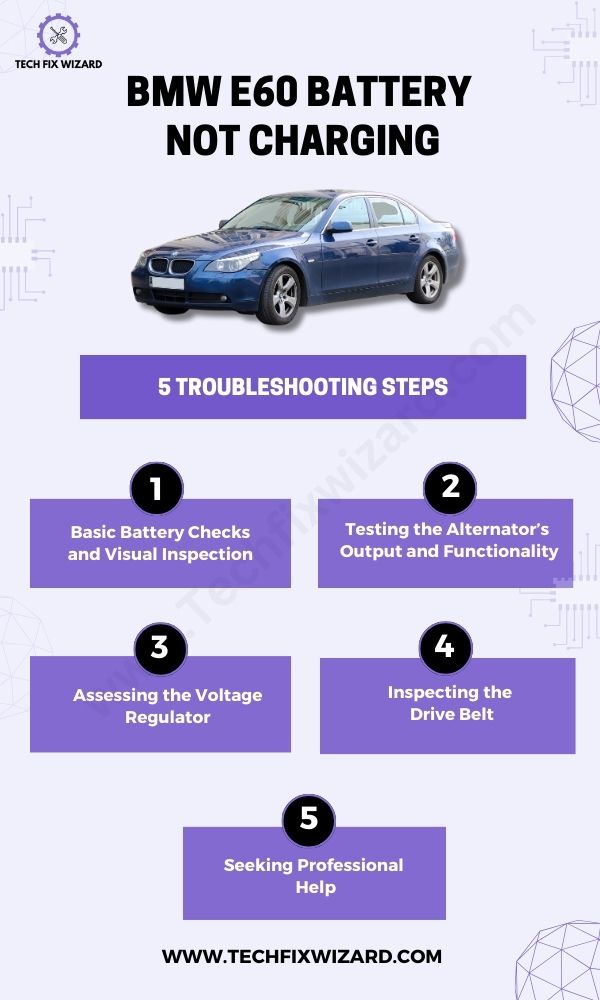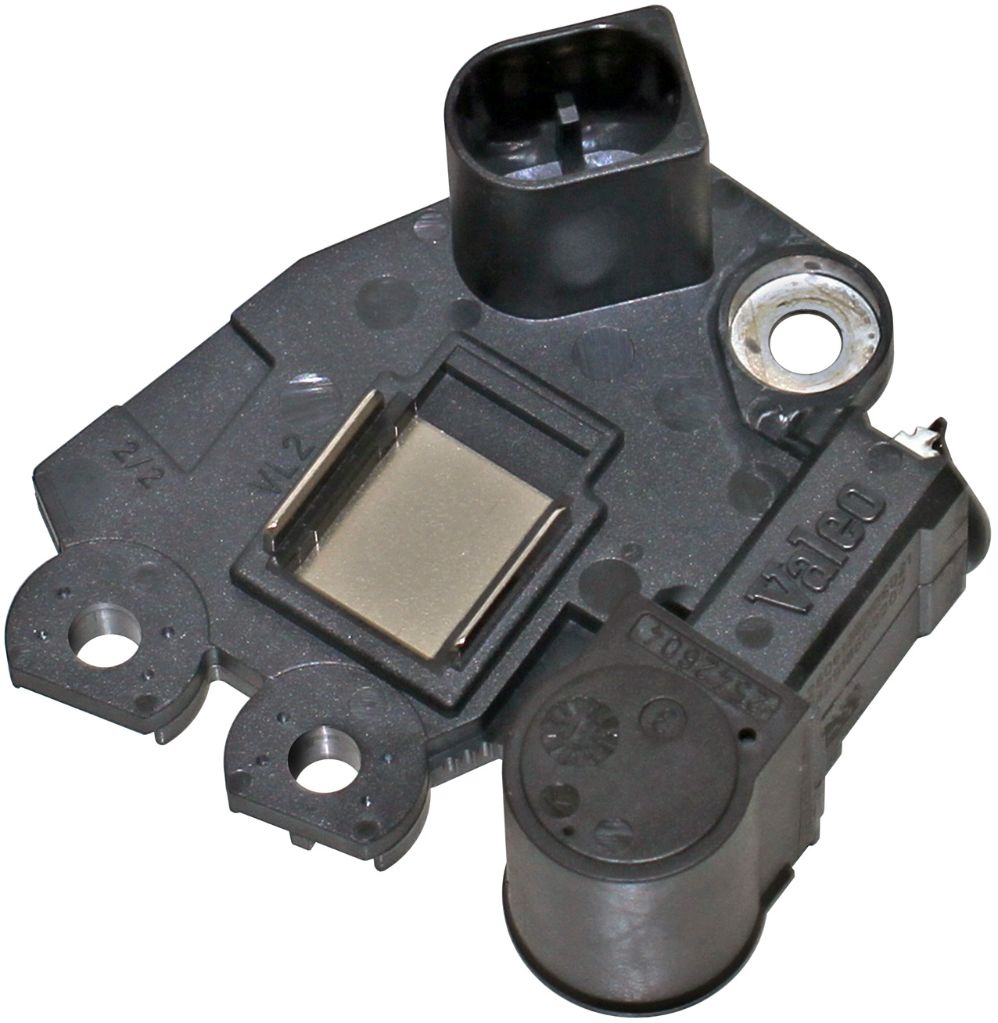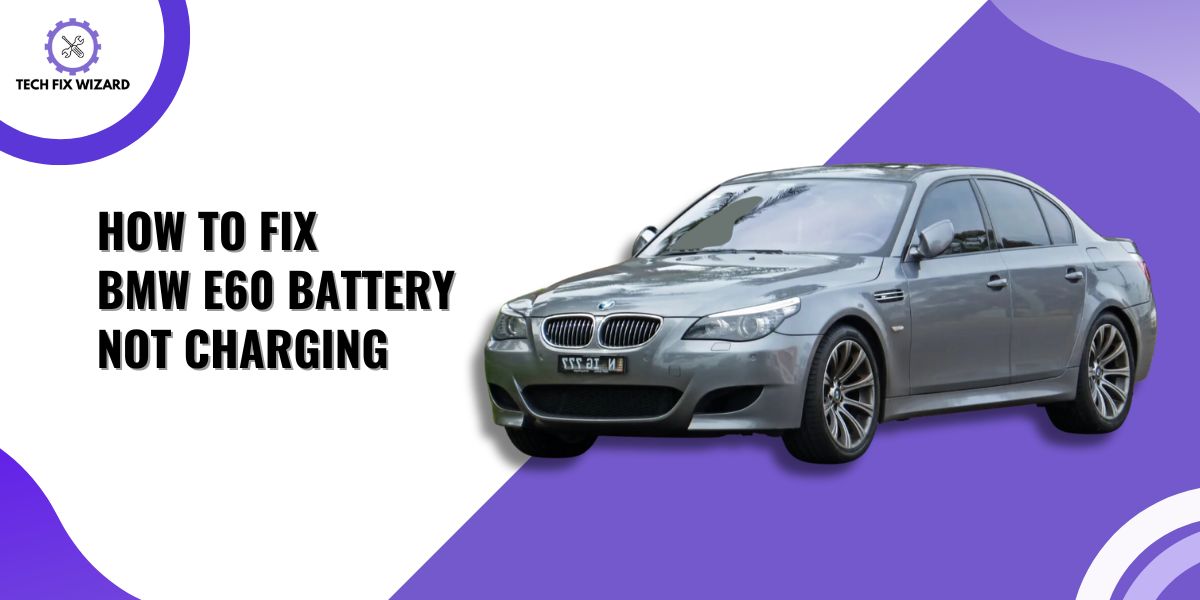Your BMW E60 isn’t just a car; it embodies incredible engineering and driving joy.
However, dealing with the hassle of a BMW E60 battery not charging can disrupt your plans and leave you scratching your head.
But don’t worry! In this guide, we’ll uncover possible reasons for this issue and give you steps to troubleshoot, ensuring your BMW gets back on track with a fully charged battery.
Contents
- 1 5 Potential Causes of BMW E60 Battery Not Charging
- 2 Troubleshooting BMW E60 Battery Not Charging Issue
- 3 1. Basic Battery Checks and Visual Inspection
- 4 2. Testing the Alternator’s Output and Functionality
- 5 3. Assessing the Voltage Regulator
- 6 4. Inspecting the Drive Belt
- 7 5. Seeking Professional Help
- 8 Resolving the BMW E60 Battery Not Charging Issues
- 9 1. Replacing the Battery
- 10 2. Replacing the Alternator
- 11 FAQs
- 12 Why is my BMW E60 battery not charging?
- 13 How can I determine if my BMW E60 battery is not charging?
- 14 Can a faulty alternator cause a BMW E60 battery not to charge?
- 15 How can I check if my BMW E60 alternator is working properly?
- 16 Can a worn-out battery cause a BMW E60 battery not to charge?
- 17 Is it safe to drive with a BMW E60 battery not charging?
- 18 How long does it take to replace a BMW E60 alternator?
- 19 How much does it cost to replace a BMW E60 alternator?
- 20 Can a BMW E60 battery not charging be fixed without professional help?
- 21 Are there any preventive measures to avoid a BMW E60 battery not charging issue?
- 22 Where can I get my BMW E60 battery charging issue diagnosed and repaired?
- 23 Official References & Resources
5 Potential Causes of BMW E60 Battery Not Charging
When faced with a BMW E60 battery not charging issue, it’s essential to identify the underlying causes before diving into troubleshooting.
Understanding the potential causes allows for a systematic approach, saving time and effort in resolving the problem effectively.
To aid in the identification of potential causes for the BMW E60 battery not charging the table below outlines the main culprits and their corresponding symptoms:
| Potential Causes | Symptoms |
|---|---|
| 1. Faulty Alternator | Dim headlights, dead battery, warning lights |
| 2. Malfunctioning Voltage | Inconsistent charging, flickering lights |
| 3. Regulator | Abnormal voltage readings on a multimeter |
| 4. Battery Issues | Deterioration, insufficient voltage, loose connections |
| 5. Electrical System | Wiring issues, blown fuses, malfunctioning ignition switch |
Troubleshooting BMW E60 Battery Not Charging Issue
When faced with a BMW E60 battery not charging issue, it’s essential to address the problem promptly to avoid getting stranded with a dead battery.
By following a step-by-step approach, you can potentially resolve the issue without extensive repairs or replacements.
Let’s explore the troubleshooting steps to tackle the BMW E60 battery not charging problem effectively.

1. Basic Battery Checks and Visual Inspection
Before delving into more complex troubleshooting methods, it’s crucial, to begin with basic battery checks and a thorough visual inspection.
This initial step helps ensure that the issue isn’t due to a simple oversight or an easily fixable problem.
Here’s how to proceed:
1. Visual Inspection:
Performing a thorough inspection of the battery is essential to identify potential issues that may be causing the charging problem.
Check out the following battery inspection checklist to ensure a systematic examination of the battery and related components:
- Look for signs of physical damage, corrosion, or leaks.
- Check battery terminals and cables’ tightness and cleanliness.
- Inspect the condition of the wirings, are they lost or frayed in the battery compartment?
- Check for signs of a blown fuse or damage to the fuse box related to the charging system.
2. Battery Voltage Check:
Follow the steps below to measure the battery’s voltage and evaluate its condition accurately:
- Use a multimeter to measure the battery’s voltage.
- Ensure the ignition and all electrical accessories are off.
- Connect positive (red) leads to the battery’s positive terminal, and negative (black) leads to the negative terminal.
- A fully charged battery should read around 12.6 volts or higher. If the voltage is significantly lower, it may indicate a weak or discharged battery.
3. Battery Load Test:
To thoroughly assess the performance of the battery and determine its ability to hold a charge, it is recommended to conduct a battery load test.
- Fully charge the battery before starting the test
- Connect a load tester or battery load-testing device to the battery
- Set the load tester to the appropriate load level
- Activate the load tester and monitor the battery voltage and performance
- Observe the battery’s performance under load
- Continue the load test for the recommended duration
- Check the test results and analyze the battery’s performance
- Make an informed decision based on the battery’s performance and consider replacing the battery if necessary
2. Testing the Alternator’s Output and Functionality
The alternator is a vital component of a vehicle’s electrical system, including in the case of a BMW E60.
It plays a critical role in generating electrical power to charge the battery and power the various electrical components of the vehicle, such as the lights, stereo system, and onboard computers.
The table below outlines the comprehensive steps involved in testing the alternator’s output and functionality when troubleshooting a BMW E60 battery not charging issue.
| Step | Description |
|---|---|
| 1. Prepare the necessary tools | Safety gloves, goggles, and multimeter with voltage testing capability |
| 2. Take safety precautions | Turn off the engine, park the vehicle on a flat surface |
| 3. Access the alternator | Locate it near the engine, and identify electrical connections |
| 4. Set up the multimeter | Set it to voltage testing mode, and connect leads to alternator terminals |
| 5. Start the engine | Have an assistant start the engine while observing the multimeter |
| 6. Monitor multimeter readings | Check for the expected voltage output range |
| 7. Perform additional tests | Load test, and check for unusual noises or heat |
| 8. Interpret test results | Determine if the alternator is functioning properly |
| 9. Take appropriate action | Repair or replace the alternator if necessary |
| 10. Reconnect the battery | Ensure a secure connection |
3. Assessing the Voltage Regulator
The voltage regulator is a critical component in the charging system of a vehicle, including the BMW E60.
Its primary function is to regulate the electrical output of the alternator to ensure a steady and controlled voltage to the battery and the vehicle’s electrical components.
Assessing the voltage regulator for proper operation is crucial when troubleshooting charging issues.
Here are the key steps involved:
| Step | Description |
|---|---|
| 1. Use a multimeter | Set the multimeter to the voltage testing mode. |
| 2. Test the voltage regulator’s output | Connect the multimeter’s positive lead to the alternator’s B+ terminal and the negative lead to solid ground. |
| 3. Desired voltage readings | A properly functioning voltage regulator should maintain a consistent voltage output within a specific range (e.g., 13.5-14.5 volts). |
| 4. Perform additional tests | Activate various electrical components to simulate real-world conditions and observe the voltage stability. |
| 5. Interpret the test results | Compare the measured voltage readings with the expected range. |
| 6. Possible solutions | If the voltage regulator is faulty, consult a professional for repair or replacement. |

4. Inspecting the Drive Belt
Now it’s time to look closely at the drive belt, which wraps around various components in your car’s engine and helps transfer power to different systems like the alternator, air conditioning compressor, and power steering pump.
A worn-out or damaged drive belt can lead to problems with charging the battery.
Here are some things you should check when inspecting the drive belt:
| Inspection Steps | Description |
|---|---|
| 1. Signs of Wear and Tear | Look for cracks, frayed edges, or shiny spots on the surface of the belt. |
| 2. Tension Check | Use a tension gauge tool to ensure the drive belt is taut but not overly tight. |
| 3. Pulley Inspection | Check for smooth operation without any wobbling or misalignment of the pulleys. |
| 4. Replacement if Necessary | If you notice any damage or significant wear and tear, the drive belt should be replaced immediately. |
By maintaining your vehicle’s drive belt in good condition, you can prevent issues with battery charging caused by problems with power transfer from other systems in your car’s engine.
5. Seeking Professional Help
If, despite your best efforts and thorough troubleshooting, you still can’t pinpoint the exact cause of an issue with the BMW E60 battery not charging, it is highly recommended to seek professional help.
Automotive technicians and specialists have the expertise, tools, and experience to diagnose and resolve complex electrical problems effectively.
Resolving the BMW E60 Battery Not Charging Issues
If you have pinpointed issues with the battery or alternator and are considering replacing them, follow the instructions below for a successful replacement.
1. Replacing the Battery
Follow the steps below to replace your battery if it requires replacement to resolve the BMW E60 not charging issue:
- Gather the necessary tools: A wrench or socket set, gloves, and safety glasses.
- Locate the battery: Typically in the trunk, under the carpet, or a cover. Refer to the vehicle’s manual for precise location.
- Prepare for battery replacement: Turn off the engine and electrical components. Put on gloves and safety glasses.
- Disconnect the negative terminal: Loosen the nut and remove the cable from the negative terminal (-).
- Disconnect the positive terminal: Loosen the nut and remove the cable from the positive terminal (+).
- Remove the battery: Check for securing brackets or straps. Lift the battery out of its compartment.
- Clean the battery compartment: Inspect and clean the compartment using a battery cleaner or baking soda mixture.
- Install the new battery: Position the new battery correctly and secure it with brackets or straps.
- Reconnect the positive terminal: Slide the positive cable onto the positive terminal (+) and tighten the nut securely.
- Reconnect the negative terminal: Slide the negative cable onto the negative terminal (-)and tighten the nut securely.
- Perform a final check: Ensure all connections are tight and secure.
- Test the new battery: Start the vehicle and check electrical component functionality. Monitor battery performance.
2. Replacing the Alternator
You can follow the 11 steps below to replace the alternator in your BMW E60:
- Gather the necessary tools: Ensure you have the required tools such as a socket set, wrenches, and a belt tensioner tool.
- Disconnect the battery: Safely disconnect the negative terminal of the battery to prevent any electrical mishaps.
- Locate the alternator: Identify the position of the alternator, typically situated at the front of the engine near the top.
- Remove the serpentine belt: Use a belt tensioner tool to relieve tension and remove the serpentine belt from the alternator pulley.
- Disconnect electrical connections: Carefully detach the power cable and other electrical connectors or sensors from the alternator.
- Remove the mounting bolts: Loosen and remove the mounting bolts that secure the alternator to the engine block.
- Take out the old alternator: Gently remove the old alternator from its mounting position, being cautious not to damage surrounding components.
- Install the new alternator: Position the new alternator in place and secure it with the mounting bolts, ensuring they are tightened properly.
- Reconnect electrical connections: Attach the power cable and other electrical connectors or sensors to the new alternator.
- Reinstall the serpentine belt: Use the belt tensioner tool to place the serpentine belt back onto the alternator pulley, ensuring proper alignment.
- Reconnect the battery: Safely reconnect the negative terminal of the battery to restore electrical power.
FAQs
Why is my BMW E60 battery not charging?
There could be several reasons for this, such as a faulty alternator, a worn-out battery, a loose or damaged connection, or a problem with the charging system.
How can I determine if my BMW E60 battery is not charging?
You may notice signs like dimming headlights, a weak or dead battery, frequent jump-starting, or a warning light on the dashboard indicating a charging system issue.
Can a faulty alternator cause a BMW E60 battery not to charge?
Yes, a faulty alternator is a common cause of a battery not charging. The alternator is responsible for generating electricity to charge the battery while the engine is running.
How can I check if my BMW E60 alternator is working properly?
One way to check the alternator is to use a multimeter to measure the voltage across the battery terminals while the engine is running. It should read around 13.8 to 14.4 volts.
If it’s significantly lower or higher, there may be an issue with the alternator.
Can a worn-out battery cause a BMW E60 battery not to charge?
Yes, a worn-out or defective battery may not hold a charge even if the charging system is functioning properly.
Consider having the battery tested or replaced if necessary.
Is it safe to drive with a BMW E60 battery not charging?
It’s generally not recommended to drive with a battery that is not charging.
As the battery depletes, the car’s electrical systems may fail, and you could end up stranded if the battery dies completely.
How long does it take to replace a BMW E60 alternator?
The time required to replace the alternator can vary depending on the specific circumstances and the mechanic’s experience. It typically takes a few hours.
How much does it cost to replace a BMW E60 alternator?
The cost of replacing an alternator can vary depending on factors such as the model year, location, and whether it’s an OEM or aftermarket part. Generally, it can range from $400 to $800 or more, including parts and labor.
Can a BMW E60 battery not charging be fixed without professional help?
Simple issues like loose connections or a worn-out battery can sometimes be addressed without professional help.
However, for more complex issues like an alternator or charging system problems, it’s best to seek professional assistance.
Are there any preventive measures to avoid a BMW E60 battery not charging issue?
Regular maintenance, including battery checks, alternator inspections, and electrical system diagnostics, can help identify potential issues before they become major problems.
Additionally, keeping the battery terminals clean and free of corrosion is important.
Where can I get my BMW E60 battery charging issue diagnosed and repaired?
It is recommended to take your BMW E60 to a reputable auto repair shop or dealership with experienced technicians who specialize in BMW vehicles.
They will have the necessary tools and expertise to diagnose and fix the battery charging issue effectively.
Official References & Resources
Our research for providing accurate information about BMW involved a thorough analysis of official resources, including the official BMW website owner’s manuals, technical specifications, and relevant support forums.
Our research and data gathering involved thorough analysis of the official websites, including:

John Paul is a tech enthusiast dedicated to troubleshooting. He is passionate about fixing glitches, simplifying complexities, and empowering others in the digital realm.

